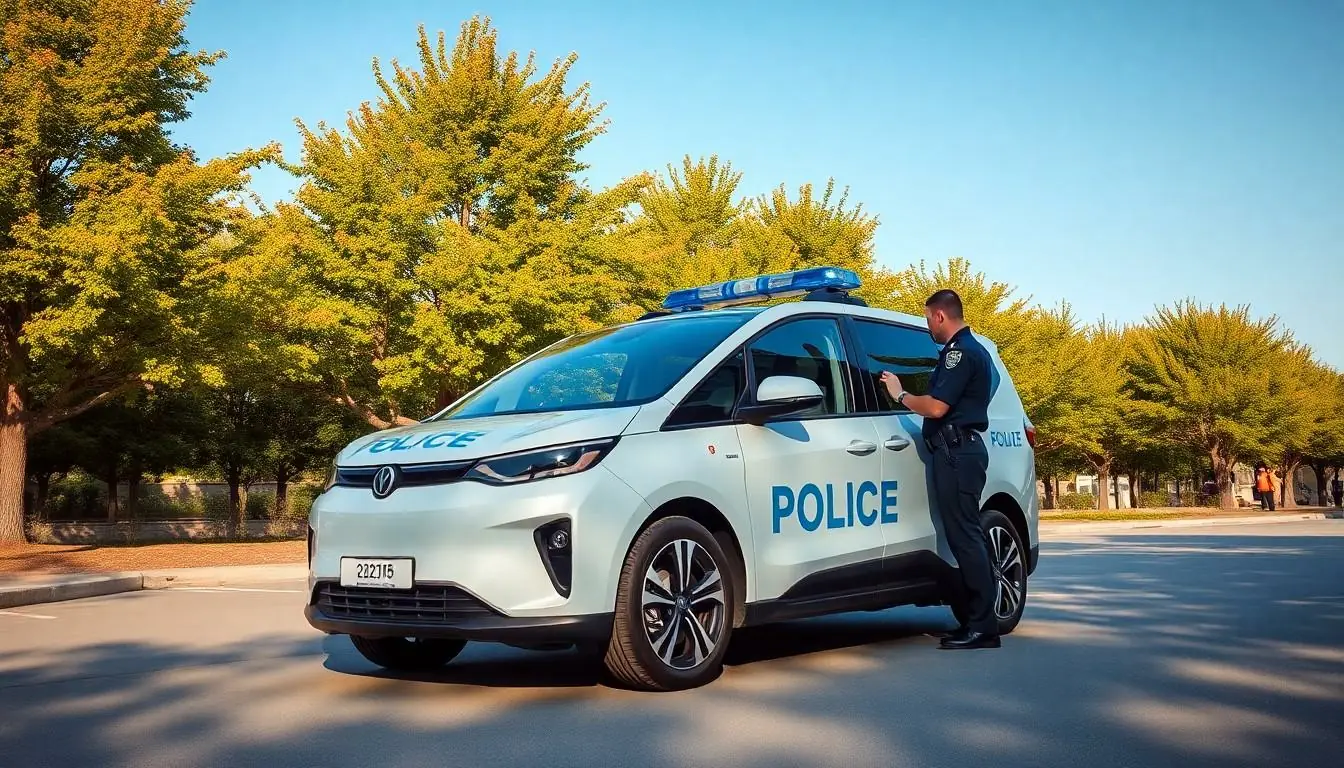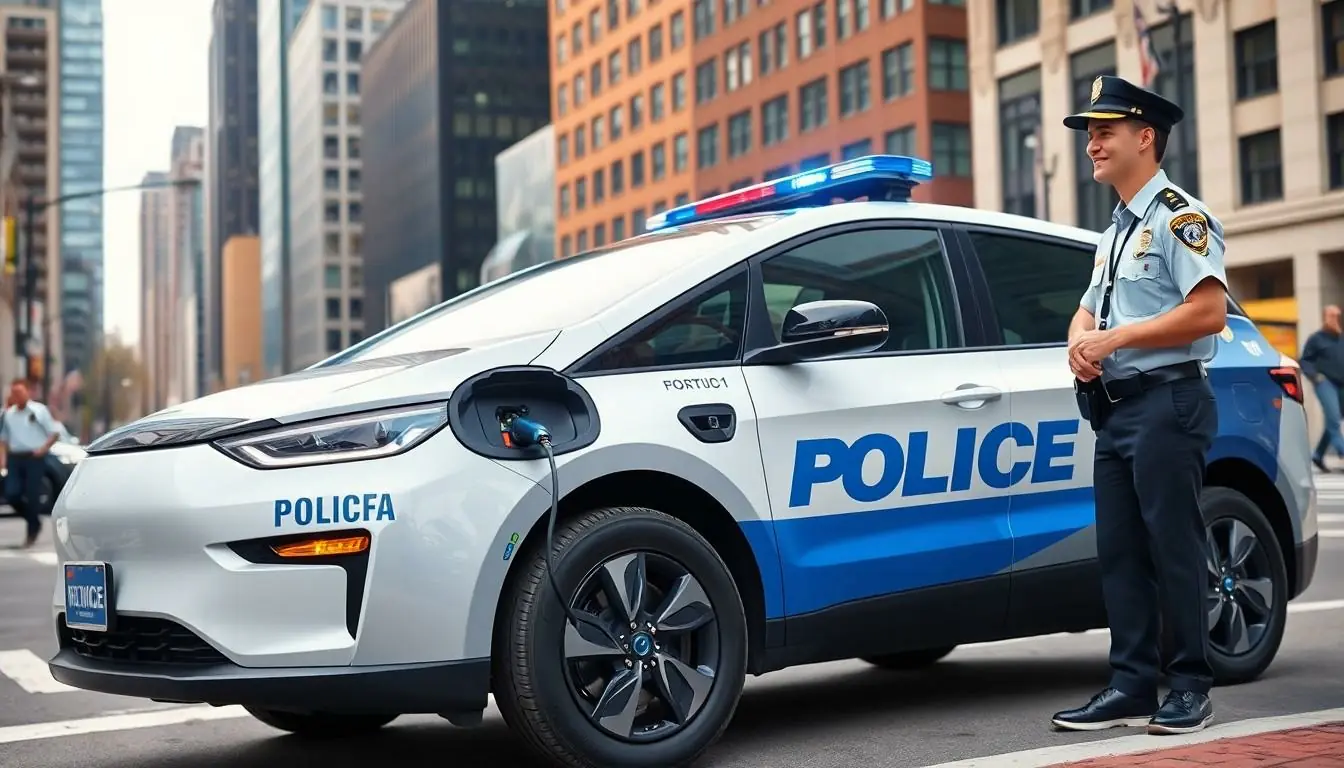The future of law enforcement is charging ahead—literally! Electric police vehicles are rolling onto the scene, and they’re not just here to save the planet; they’re also here to save taxpayers some serious cash. Imagine a squad car that runs silently, doesn’t guzzle gas like it’s at an all-you-can-eat buffet, and can zoom past gas stations without a second thought. It’s like having a superhero in the fleet, minus the cape.
Table of Contents
ToggleOverview of Electric Police Vehicles
Electric police vehicles are transforming law enforcement operations. These vehicles provide numerous advantages, including enhanced fuel efficiency and reduced emissions. Operating quietly, they allow officers to respond discreetly during sensitive situations. Frequent gas station stops become unnecessary, leading to lower operational costs.
Numerous police departments have already adopted electric vehicles into their fleets. The reduction in maintenance costs significantly contributes to overall savings. With fewer moving parts compared to traditional combustion engines, electric vehicles require less frequent service.
Performance metrics also show electric police vehicles excel in various aspects. Many models offer comparable acceleration and handling to their gasoline counterparts. Environmental benefits include lower greenhouse gas emissions, making these vehicles a more sustainable option for city transportation.
Cities like Los Angeles and Seattle have reported positive outcomes from integrating electric vehicles into their police fleets. Officers appreciate the quieter operation during community engagement, enhancing interactions with the public. This shift aligns with broader sustainability goals set by these municipalities.
Technology plays a crucial role in the effectiveness of electric police vehicles. Most models feature advanced connectivity options, enabling real-time data sharing with dispatch and other units. The incorporation of high-tech monitoring systems enhances overall vehicle safety and operational efficiency.
In light of ongoing developments in battery technology, electric police vehicles offer a viable long-term solution for law enforcement. As charging infrastructure expands, the practicality of these vehicles increases, ensuring they meet the demands of modern policing.
Benefits of Electric Police Vehicles

Electric police vehicles offer significant advantages for modern law enforcement. These benefits encompass environmental sustainability and financial savings for police departments.
Environmental Impact
Electric police vehicles contribute to reducing greenhouse gas emissions, significantly lowering the carbon footprint associated with traditional gas-powered units. According to recent studies, transitioning to electric models can decrease emissions by up to 50%. They operate quietly, minimizing noise pollution in urban environments and enhancing community relations. Many departments in cities like Los Angeles and Seattle have already reported such positive environmental effects. Utilizing electric vehicles aids in achieving sustainability goals and fostering eco-friendly public image among law enforcement agencies.
Cost Savings
Lower operational costs make electric police vehicles an attractive option for law enforcement. Electric models typically incur 80% lower fuel costs compared to gasoline vehicles. Maintenance expenses also decline, as these vehicles consist of fewer moving parts, reducing the frequency of repairs. Many departments save thousands annually by adopting electric fleets. The reduction in fuel consumption and maintenance needs allows for reallocation of resources towards vital community services. Evaluating these savings proves crucial for departments aiming to optimize budgets while improving public safety.
Challenges Facing Electric Police Vehicles
Electric police vehicles encounter several challenges that may hinder their widespread adoption. Law enforcement agencies must address these issues to fully leverage the benefits of electric vehicle technology.
Range Limitations
Range limitations pose a significant challenge for electric police vehicles. Many models provide a driving range of around 150 to 250 miles on a single charge. While this may suffice for short patrol shifts, longer operations can create concerns about running out of battery. Officers in remote areas or those engaged in extended pursuits may experience anxiety over potential range anxiety. Strategies like route planning or strategic battery management can help mitigate some of these concerns, yet effective solutions must be in place to enhance the reliability of electric options in law enforcement.
Charging Infrastructure
Charging infrastructure represents another hurdle for electric police vehicles. Many police departments may lack sufficient charging stations to support a full fleet of electric units. Installing charging stations at police depots and strategic locations throughout communities becomes essential for maintaining operational readiness. Generally, charging times can range from 30 minutes for fast chargers to several hours for standard home chargers. The availability of fast-charging technology can significantly reduce downtime during shifts. Departments need partnerships with local agencies or businesses to expand access to public charging options and improve response capabilities.
Technology Behind Electric Police Vehicles
Electric police vehicles integrate advanced technology that enhances law enforcement efficiency while supporting sustainability.
Battery Technology
Battery technology drives the performance of electric police vehicles. Lithium-ion batteries dominate the market, delivering impressive energy density and longevity. Some models achieve a recharge rate of 80% in under an hour, ensuring quick turnaround times for officers. With continual advancements, cutting-edge battery systems provide a range of up to 300 miles on a single charge. Research indicates that new battery chemistries may reduce charging time, further improving practicality for police operations. As battery technology evolves, its impact on electric vehicle reliability and efficiency strengthens, enabling police departments to consider electric models more seriously.
Performance Features
Performance features distinguish electric police vehicles from traditional models. Acceleration rates can rival their gas-powered counterparts, going from 0 to 60 mph in under six seconds. Maneuverability also tends to improve due to lower center of gravity in electric vehicles. Regenerative braking systems enhance efficiency, recapturing energy during braking to extend battery life. Many electric police vehicles feature large infotainment systems for real-time data access and communication with dispatch. Performance metrics reflect that electric vehicles can excel in pursuit scenarios while offering plenty of torque for quick responsiveness, essential for effective law enforcement.
Case Studies of Electric Police Vehicles in Action
Many police departments now use electric vehicles to enhance efficiency and sustainability. The Los Angeles Police Department is a notable example, incorporating several Tesla Model 3 units into its fleet. This integration has not only improved vehicle performance but also reduced emissions significantly.
In Seattle, the Seattle Police Department adopted electric Ford Mustang Mach-E vehicles. These vehicles demonstrate impressive acceleration and lower operational costs, creating a more eco-friendly patrol option. Data indicates a reduction in fuel expenses by up to 80%, allowing the department to allocate those savings to community programs.
The Phoenix Police Department has also embraced electric vehicles, utilizing Chevrolet Bolt EVs for neighborhood patrols. Charging stations installed throughout the city provide easy access to power, addressing range concerns. Officers report that these vehicles enhance community engagement through quieter patrols, fostering better relationships with residents.
Chicago is testing electric police vehicles in select districts, focusing on efficiency and response capability. Early feedback emphasizes improved handling and acceleration, matching traditional vehicles in pursuit scenarios. This initiative highlights the potential for electric vehicles to perform alongside conventional models while promoting environmental responsibility.
Departments in smaller cities like Boulder, Colorado, also experience benefits from electric vehicles. By implementing electric bikes for park patrols, officers navigate the terrain effortlessly, demonstrating versatility in operations. Each of these case studies underscores the progress police departments are making toward integrating electric vehicles into their fleets.
The shift towards electric police vehicles marks a pivotal moment in modern law enforcement. By embracing these eco-friendly alternatives, police departments can enhance operational efficiency while significantly reducing their carbon footprint. The benefits extend beyond cost savings and environmental impact, fostering stronger community relations through quieter patrols.
As technology continues to advance, the challenges surrounding range and charging infrastructure will likely diminish. This evolution will pave the way for broader adoption across various departments. With successful case studies already demonstrating the advantages of electric vehicles, the future of policing looks promising. Electric police vehicles are not just a trend; they represent a sustainable and effective approach to law enforcement in the 21st century.

